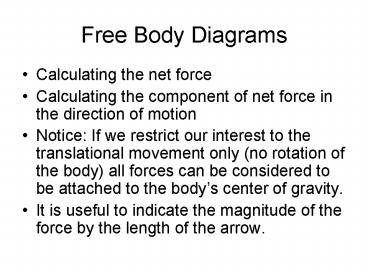Free Body Diagrams - PowerPoint PPT Presentation
1 / 20
Title:
Free Body Diagrams
Description:
It is going to pull two barges one of mass 50 000 kg and one of the mass of 100 000 kg. ... What is the tension on the cable between tug and barge 1? ... – PowerPoint PPT presentation
Number of Views:861
Avg rating:3.0/5.0
Title: Free Body Diagrams
1
Free Body Diagrams
- Calculating the net force
- Calculating the component of net force in the
direction of motion - Notice If we restrict our interest to the
translational movement only (no rotation of the
body) all forces can be considered to be attached
to the bodys center of gravity. - It is useful to indicate the magnitude of the
force by the length of the arrow.
2
Example Hebb elevator
- Hebb elevator has a mass of 400kg. It is pulled
up by a steel cable. Four people each weighing 75
kg are in the elevator planning to go up to the
lab. - What is the tension on the cable when the
elevator is at rest? - What is the tension on the cable when the
elevator is accelerating up at 1m/s2 ? - What is the tension on the cable when the
elevator is accelerating down at 1m/s2
3
Example Hebb elevator
- Hebb elevator has a mass of 400kg. It is pulled
up by a steel cable. Four people each weighing 75
kg are in the elevator planning to go up to the
lab. - What is the tension on the cable when the
elevator is at rest?
T
T -mg -700kg(-9.8m/s2) 6860N Positive is
up.
mg
4
Example Hebb elevator
- Hebb elevator has a mass of 400kg. It is pulled
up by a steel cable. Four people each weighing 75
kg are in the elevator planning to go up to the
lab. - What is the tension on the cable when the
elevator is accelerating up at 1m/s2 ?
T
T mg ma T ma-mg m(a-g) 700kg(1m/s2 -
(-9.8m/s2) 700kg 10.8m/s2 7560N
mg
5
Example Hebb elevator
- Hebb elevator has a mass of 400kg. It is pulled
up by a steel cable. Four people each weighing 75
kg are in the elevator planning to go up to the
lab. - What is the tension on the cable when the
elevator is accelerating down at 1m/s2?
T
T mg - ma T -ma-mg m(-g-a) 700kg
(-(-9.8 m/s2) (-1 m/s2)) 700kg 8.8m/s2
6160N
mg
6
Interactive systems and environment
7
Newtons third law of motion
- Whenever one object exerts a force on the
second object the second exerts an equal and
opposite to force on the first.
8
Demo People on carts 3 trialsPerson A
pushing Person BPerson B pushing Person ABoth
pushing each otherWhat results do we expect?
9
Demo with the two carts on the track and force
probes.
10
Action-Reaction Pairs of Forces
- Have to act on different bodies.
- Have identical magnitude and act in the opposite
directions - Have the same origin (for example gravitational,
elastic, magnetic, electrostatic) - Act simultaneously
11
Action reaction force paradox
- I am pushing the table the table pushes me back
with exactly the same force. Why it accelerates? - Action reaction pairs on free body diagrams
12
Propulsion forces
13
Example 1 A tug with two barges
1
2
A tug of mass m1 20 000kg and an engine which
can create thrust of 100 000 N is starting its
trip. It is going to pull two barges one of mass
50 000 kg and one of the mass of 100 000 kg. What
is going to be the acceleration of the tug and
the barges. What is the tension on the cable
between tug and barge 1? What is the tension on
the cable between the barges?
14
What is the force propelling the tug?
15
Example 1 A tug with two barges
FP 100 000N m1 20 000kg
m2 50 000
m3 100 000
Free body diagrams? a ? T1 ? (Tension on
the cable between tug and barge 1) T2 ?
(Tension on the cable between barges)
16
We can consider the horizontal motion only (we do
not expect or observe vertical motion)
-T1 FP 100 000N
-T2 T1
T2
17
- Net force on the tug
- FP T1 ax 20 000
- Net force on barge 1
- T1 T2 ax 50 000
- Net horizontal force on barge 2
- T2 ax 100 000
18
- All three vessels are moving with the same
acceleration ax - FP T1 ax 20 000
- T1 T2 ax 50 000
- T2 ax 100 000
- T1 T2 ax 50 000
- T1 ax 50 000 ax 100 000 ax 150 000
- FP T1 ax 20 000
- FP ax 20 000 T1 ax 20 000 ax 150
000 - FP ax 170 000
- ax 100000N/170 000kg 0.59 m/s2
- T2 0.59 m/s2 100 000kg 59 000N
- T1 T2 ax 50 000 88500N
19
Friction
- Kinetic friction
- Static friction
- Friction force does not depend on the contact
area! - Demo with the block pulled by a spring scale
20
Coefficients of friction
- Static
- S max(fs)/n
- fs ? ? S n
- Kinetic
- K fk /n
- fk ? K n
- ? S gt ? K































